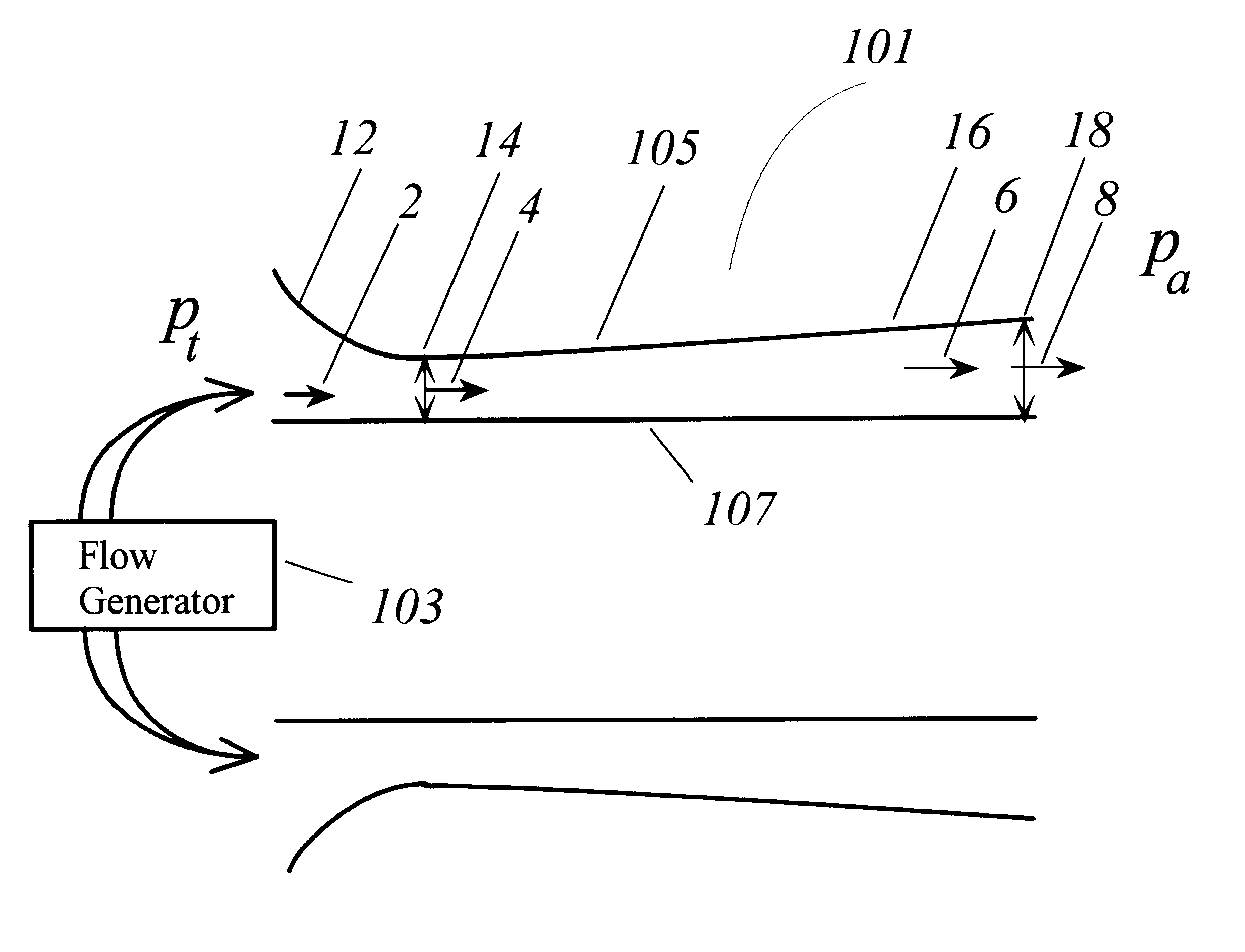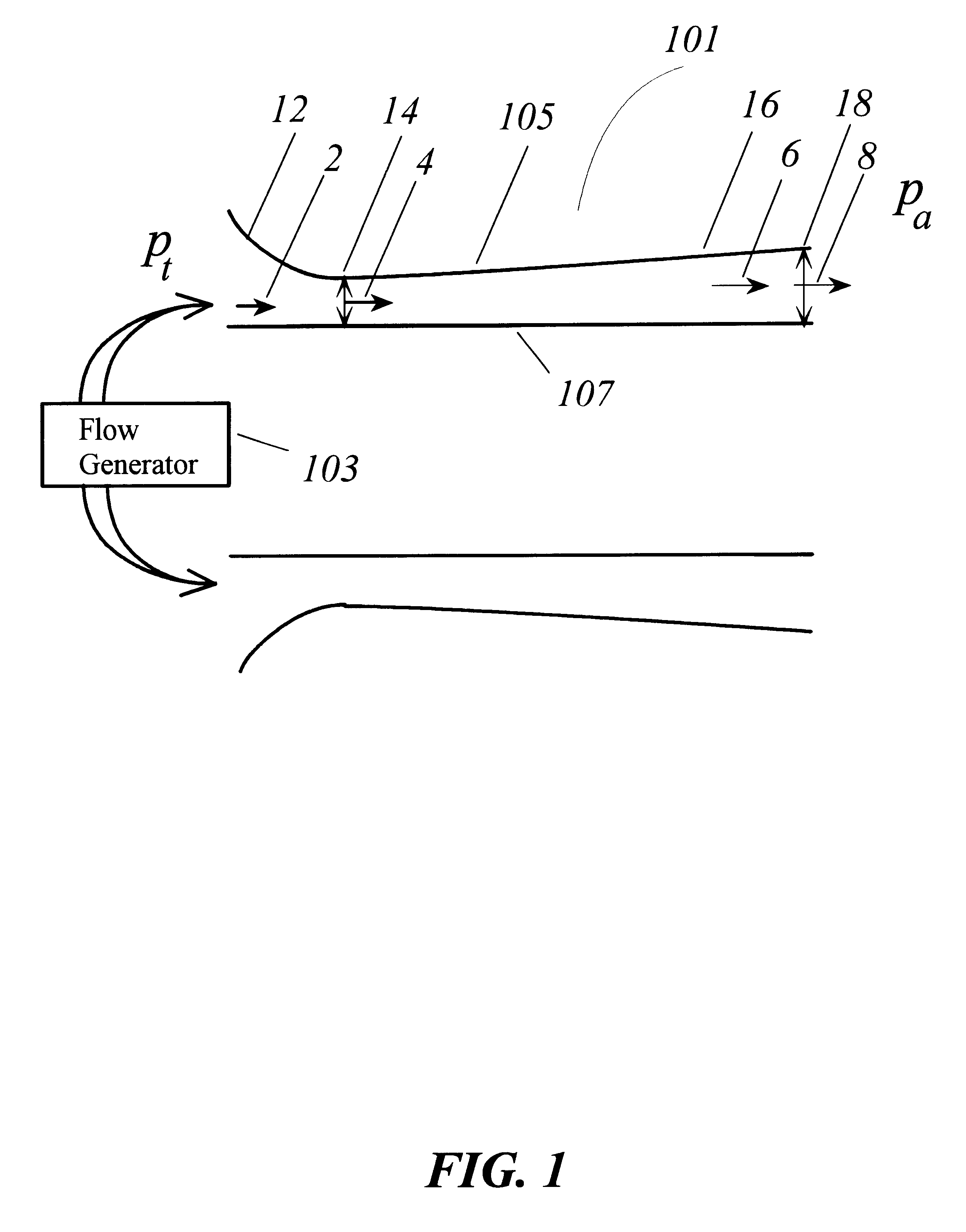Mixing enhancement using axial flow
a technology of axial flow and enhancement, applied in the field of mixing enhancement, can solve the problems of reduced efficiency, difficult to complete mixing, and excessive production of pollutants
- Summary
- Abstract
- Description
- Claims
- Application Information
AI Technical Summary
Problems solved by technology
Method used
Image
Examples
first embodiment
FIG. 1 illustrates the present invention. FIG. 1 shows an exemplary converging-diverging duct 101. From area 12 to area 14, the duct 101 is converging. From area 14 to area 18, the duct 101 is diverging.
The duct 101 comprises an effective outer wall 105, an effective inner wall 107, a cross sectional area A.sub.1 at area 14, and an exit area A.sub.e at area 18. The cross sectional area A.sub.1 and the exit area A.sub.e are different in size.
As shown in FIG. 1, the converging-diverging feature of the duct 101 is caused by the shape of the effective outer wall 105. Equivalently, this feature can also be caused by the shape of the effective inner wall 107, or by both effective walls.
The effective walls 105, 107 can be either rigid or fluid. For example, the effective inner wall can be formed by a centerbody, or by an outer wall of a fluid stream nozzle. In such cases, the effective inner wall is rigid. The effective inner wall can also be formed by a boundary of a fluid stream, in whic...
second embodiment
FIG. 5 illustrates the present invention. FIG. 5 shows a longitudinal sectional view of an exemplary converging-diverging-converging duct 501. From area 23 to area 25, the duct 501 is converging. From area 25 to area 29, the duct 501 is diverging. From area 29 to area 33, the duct 501 is converging.
The duct 501 comprises an effective outer wall 505, an effective inner wall 507, a cross sectional area A.sub.min at area 29, a maximum area A.sub.max at area 29 and an exit area A.sub.e at area 33. The cross sectional area A.sub.min and the exit area A.sub.e are different in size.
As shown in FIG. 5, the converging-diverging-converging feature of the duct 501 is caused by the shape of the effective outer wall 505. Equivalently, this feature can also be caused by the shape of the effective inner wall 507, or by both effective walls.
The effective walls 505, 507 can be either rigid or fluid. For example, the effective inner wall 507 can be formed by a centerbody, or by an outer wall of a jet...
third embodiment
FIG. 8 is the present invention, which comprises a duct 801, a flow generator 103, and a centerbody 809. From area 812 to area 816, the duct 801 is converging. From area 816 to area 820, the duct 801 is shown as constant for illustrative purposes only, it can also be diverging. From area 820 to 826, the duct 801 is diverging.
Referring to FIG. 8, the duct 801 comprises an effective outer wall 805, an effective inner wall 807, a cross sectional area A.sub.min at area 816, and an exit area A.sub.e at area 826. The cross sectional area A.sub.min is smaller than the exit area A.sub.e. The effective inner wall 807 is formed by the centerbody 809. Since the centerbody 809 extends past the exit area 828, the effective inner wall 807 is longer than the effective outer wall 805. The present invention does not require that the centerbody be extended past the exit area. The endpoint 830 of the centerbody 809 can also be coplanar with the duct exit area 826, or recessed from the termination of t...
PUM
 Login to View More
Login to View More Abstract
Description
Claims
Application Information
 Login to View More
Login to View More - R&D
- Intellectual Property
- Life Sciences
- Materials
- Tech Scout
- Unparalleled Data Quality
- Higher Quality Content
- 60% Fewer Hallucinations
Browse by: Latest US Patents, China's latest patents, Technical Efficacy Thesaurus, Application Domain, Technology Topic, Popular Technical Reports.
© 2025 PatSnap. All rights reserved.Legal|Privacy policy|Modern Slavery Act Transparency Statement|Sitemap|About US| Contact US: help@patsnap.com



